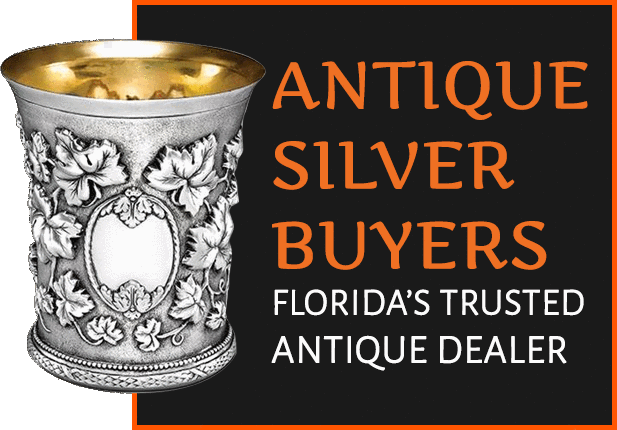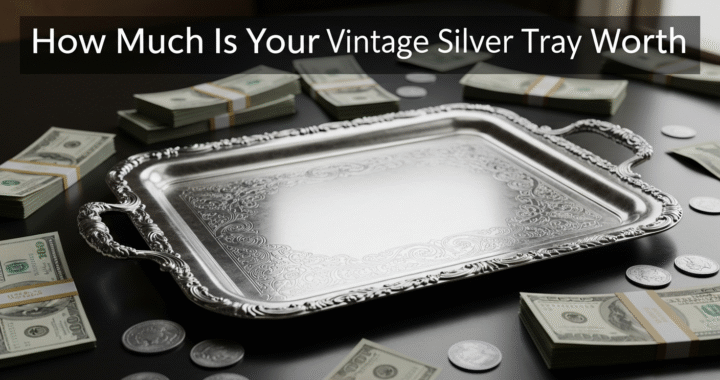Ever found an old silver tray in your storage or gotten one from a grandparent and wondered if it was worth more than just memories? A lot of collectors don’t notice these beautiful pieces because they don’t know they could be sitting on a hidden treasure. Silver trays are more than just fancy serving dishes; they have a long history, are well-made, and are worth real money.
Let’s talk about how to figure out how much your old silver tray is really worth and what makes one piece more valuable than another.
The Uncertainty About the Value of Old Silver
Most people who own old silverware, especially trays, don’t know how to figure out how much it’s worth. They might polish it with household polish, use it as decoration, or put it away without knowing how much it’s worth.
The problem? Not all shiny silver trays are made of pure silver. Some are silver-plated, while others are sterling or coin silver. The market value of each type is very different.
Also, the market for antique silver changes based on trends, the price of metal, and what collectors want. If you don’t get the right advice, you might sell your piece for a lot less than it’s worth or not value it enough.

Why You Undervaluing Your Silver Treasure
Imagine this: someone gets a beautiful vintage silver tray as a gift and sells it at a yard sale for $50, only to find out later that it was a 19th-century sterling silver piece worth more than $1,000. Sadly, this happens more often than you might think.
A lot of people think that silver-plated trays are sterling or don’t notice small but important details like maker’s marks, hallmarks, or hand-chased designs that can greatly affect value. Scratches, spots, or cleaning that isn’t done right can damage the patina, making the tray less appealing to buyers.
Your old silver tray might not just be a pretty thing; it could be a valuable piece of history and art that you own.
Find Out How Much Your Old Silver Tray Is Worth
1. Look for Hallmarks or Maker’s Marks
Look for stamps on the back or handles that say “925,” “Sterling,” or “Coin Silver.” There are important clues to authenticity and age in the form of symbols or letters that show the silversmith, manufacturer, or country of origin.
2. Check the silver Content
Real silver doesn’t have a magnetic field and reacts differently to acid tests. Talk to a professional appraiser to get the most accurate results.
3. Check out the skill and design.
A hand-engraved pattern, fancy handles or decorations around the rims generally add value. Whether Georgian or Art Deco, the collectors are looking for trays that reflect the art of their era.
4. Think about the size, weight, and condition
Heavier sterling trays usually sell for more. Condition is important; dents, scratches, or repairs can lower value, so be careful.
5. Look up the maker or pattern
Some brands, like Gorham, Tiffany & Co., and Reed & Barton, are very popular with collectors. Limited editions or rare patterns can make something worth more on the market. You can use online reference books to help you compare prices.
6. Get an Expert Appraisal
Purity, history and the current market for gold and silver are all considered by a certified appraiser when determining their metals’ worth. Many will offer a free verbal appraisal or based on a photo or digital images.
Learning about the Past of Silver Trays
People have loved silver trays since the 17th century because they are beautiful and show wealth. In Victorian and Edwardian homes, they were used to serve tea, show off fine china, or even show off small collectibles.
Knowing when and where your tray was made can help you figure out how much it’s worth and tell a fascinating story about how it was made and what it was used for.
Trends in the Market Right Now
Victorian-style trays with lots of detail and mid-century Art Deco designs are very popular right now.
Depending on the maker, design, and condition, heavy sterling silver trays can sell for $500 to $2,000.
Silver-plated trays are worth more as decorations, usually between $50 and $150.
Different kinds of silver trays:
Sterling Silver (925): 92.5% pure silver; the most valuable.
Coin Silver: Common in 19th-century America, this type of silver is usually 90% silver.
Silver-Plated: A base metal that has been covered in silver, which makes it less valuable.
Sheffield Plate and Britannia Silver: Old types that are sometimes worth collecting.
Where to Sell or Trade Your Tray
Auction Houses: Sotheby’s, Christie’s, or your local auction.
Specialty Dealers: Antique shops and silver dealers you can trust.
Online marketplaces like eBay, 1stDibs, or Ruby Lane, where you can find high-quality photos.
Tips for DIY Identification
• Look at the hallmarks and maker’s marks.
• Try the magnet test (real silver isn’t magnetic).
• Look for natural patina, which makes the item look more real and valuable.
Frequenty Asked Questions
Q1: How do I know if my tray is real or fake?
A: Look for signs like “925” or the name of the maker. If you’re not sure, check from expert.
Q2: Are trays that are scratched worth something?
A: Yes, rare designs or makers can still get a lot of money.
Q3: Do trays with engravings cost more?
A: Fancy hand engraving usually makes collectors more interested.
Last Thoughts
Your vintage silver tray is more than just a pretty thing; it’s a piece of history that shows how things were made, how people used to do things, and how elegant they were. Knowing the true value of something gives you the power to make smart choices about whether to sell it, display it, or keep it as a family heirloom. Are you ready to find out how much your silver tray is worth? Get in touch with a reliable antique silver expert or appraiser today. That tray that’s been sitting on your shelf for a while might be your next favorite thing.
👉 Want to know its real value? Reach out to Antique Silver Buyers and let our experts guide you with a quick, honest appraisal.







